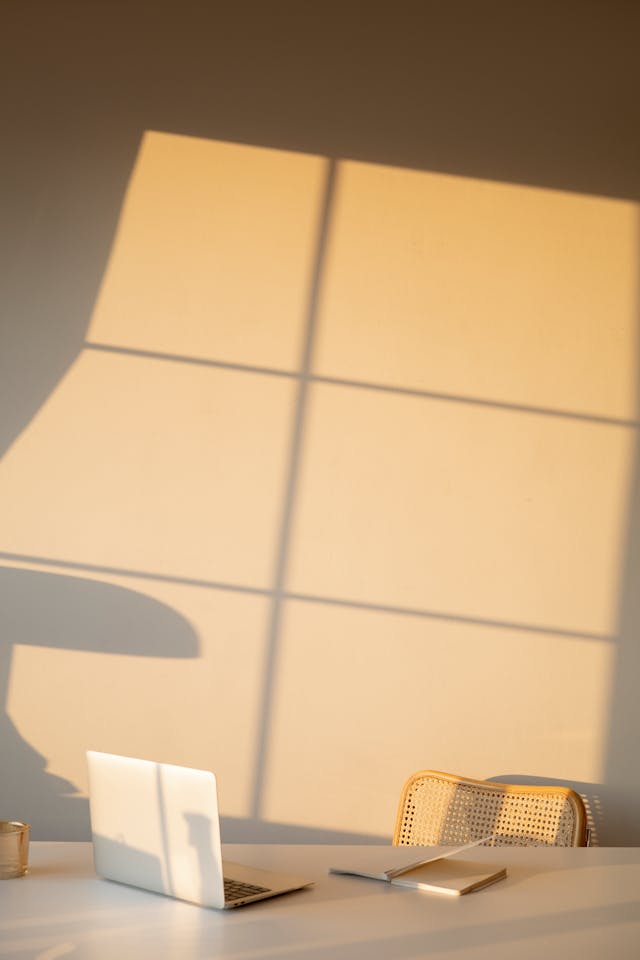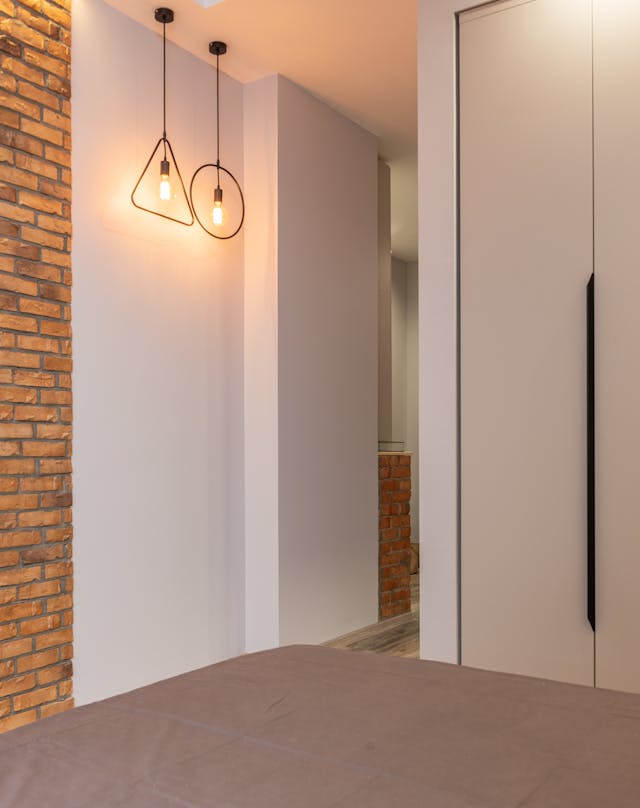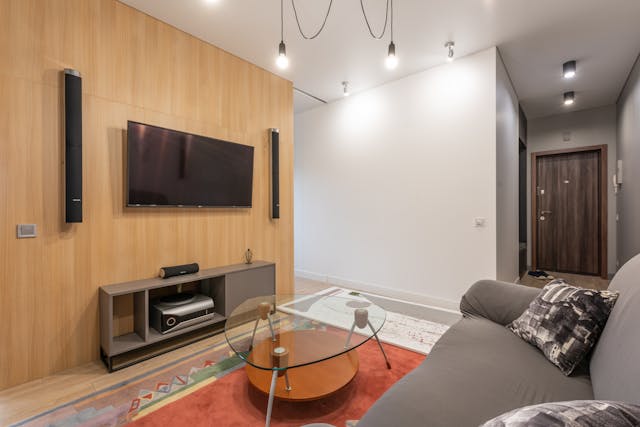Lighting can make or break the colors you choose for your space. Natural light shifts throughout the day, changing how colors appear. North-facing rooms might make colors seem cooler, while south-facing rooms reveal them in a warm glow. Artificial lighting also plays a big part; halogen lights bring out the true colors, while LEDs can adjust to make your chosen hues look just right. Even the type of bulb affects how warm or cool shades feel. Don’t forget, the finish of your paint can enhance or soften the impact of these lighting effects. Choosing the right combinations will enhance your décor, exposing layers of beauty you’ll love to explore further.
Key Takeaways
- Natural light shifts throughout the day, altering the perception of paint colors in a room.
- Different artificial light sources, such as LED and fluorescent, impact the intensity and hue of paint colors.
- Incandescent bulbs enhance warm colors, making spaces feel cozier, while cool colors may appear duller.
- Paint finishes, from gloss to flat, significantly affect how colors perform under various lighting conditions.
- The color temperature and type of lighting should be considered when choosing paint colors to ensure they appear as intended.
Understanding Natural Light
Natural light, constantly shifting due to the sun’s position, seasons, weather, and the specific location of a room, plays an important role in how you perceive paint colors. This ever-changing illumination can dramatically affect the appearance of colors on your walls. Understanding the impact of natural light on color perception is vital when choosing paint for any room.
In north-facing rooms, you’ll find the light has a cool, bluish tint, making colors appear slightly different than you might expect. This unique lighting can influence the mood and feel of the space, often requiring careful consideration of color choices to counterbalance the coolness.
South-facing rooms, on the other hand, bask in more intense light, enhancing the brightness and vibrancy of paint colors. This abundance of light can make colors pop, offering a lively and dynamic ambiance that’s perfect for spaces where you spend a lot of time during the day.
East-facing rooms enjoy a warm light in the morning that changes throughout the day, affecting how colors are perceived. This varying warmth provides a unique opportunity to play with color tones that shift character with the light, creating a dynamic and inviting environment.
Properly harnessing natural light can either enhance or diminish the perceived brightness of paint colors, making it a vital factor in your color selection process.
The Role of Artificial Light
Just as the sun shapes our day, artificial lighting greatly influences how paint colors are perceived in any interior space. Different types of artificial light, from fluorescent to LED, play pivotal roles in the perception of paint colors, affecting both their intensity and hue.
Halogen bulbs shine in offering a truer color representation, making them a stellar choice for showcasing the vibrancy of your chosen paint colors. They illuminate spaces in a way that closely mimics natural light, ensuring the colors on your walls look as intended, regardless of the time of day.
Fluorescent lights, on the other hand, emit a cooler, bluish tone. This can slightly alter how paint colors appear, especially in areas where natural light doesn’t reach as freely. It’s a lighting option that calls for careful consideration, especially when selecting paint tones for your space.
LED lighting stands out for its versatility in color temperatures. With LEDs, you’re in control, able to adjust the warmth or coolness of a room with the switch of a bulb. This flexibility allows for precise tuning of how colors are perceived, enabling you to create the perfect ambiance for every room in your home.
Incandescent Bulb Effects
Moving from the versatility of LED lighting, let’s explore how incandescent bulbs uniquely impact the colors in your home. These bulbs, known for their cozy glow, notably influence the ambiance and perception of paint colors. They’re particularly adept at intensifying warm colors, making spaces feel more inviting.
| Impact on Colors | Effect |
|---|---|
| Warm Colors | Enhances and intensifies reds and yellows, adding a cozy atmosphere. |
| Cool Colors | Can make blues and greens appear duller, slightly muting these hues. |
| Color Temperature | Ranges from 2200K to 3000K, contributing to a warm, intimate vibe. |
| Paint Color Richness | Certain shades appear richer, more vibrant under incandescent lighting effects. |
Incorporating incandescent bulbs into your decor isn’t just about illumination; it’s about strategically enhancing the richness of your chosen paint colors. While they might not be the go-to for every scenario, their ability to transform a room into a warm, welcoming space is unparalleled. Remember, when you’re aiming for a cozy ambiance or want to amplify the elegance of warm hues, incandescent lighting is your friend.
Fluorescent Lighting Influence
Shifting to fluorescent lighting, you’ll notice a cooler, more vibrant ambiance that distinctly alters the perception of paint colors in your space. This type of lighting casts a bluish hue, making colors appear more saturated and intense. It’s the higher color temperature of fluorescent bulbs that causes this effect, impacting how warm or cool paint colors appear to your eyes.
You might find that the colors under fluorescent lighting don’t seem to match your expectations set under natural light. This is because fluorescent lighting can distort color accuracy, emphasizing the importance of testing paint colors in the lighting conditions where they’ll be viewed most.
On the bright side, the cooler color temperature of fluorescent lighting is perfect for specific tasks or areas within your home or office where a crisper, more focused light is desired. Embracing the unique qualities of fluorescent lighting allows you to tailor your space to meet your exact needs, enhancing both functionality and aesthetic appeal. Remember, understanding the impact of fluorescent lighting on paint colors can make all the difference in achieving your desired atmosphere.
Halogen Bulbs and Color
You’ll find that halogen bulbs bring out the true essence of your paint colors, enhancing reds and oranges while giving blues and greens a subtler tone. Their capacity to mimic natural light guarantees your room’s colors look vibrant and accurate. Opting for halogen lighting can greatly shift your color perception, making spaces feel more inviting and true to life.
Halogen Brightness Influence
Halogen bulbs, known for their bright, intense light, greatly enhance the vibrancy and accuracy of paint colors. You’ll find that these bulbs, with a color rendering index close to natural sunlight, are unmatched in their ability to reveal the true hues and subtleties in your space. Whether you’re illuminating warm colors like reds and oranges or aiming for perfect color balance, halogen lighting is your ally. It’s no wonder these bulbs are a favorite in retail settings, where showcasing products in their best light is paramount. By choosing halogen bulbs for your home, you’re not just lighting a room; you’re bringing out the richness and depth in every color, making artwork and decor pop with life. The right lighting transforms, and with halogen bulbs, you’re choosing vibrancy and accuracy every time.
Color Perception Shifts
Understanding how halogen bulbs impact color perception reveals why they’re a top choice for enhancing the vibrancy and accuracy of your home’s colors. With halogen lighting, you can expect:
- Enhanced color intensity, making hues pop unlike any other artificial lighting.
- Truer color representation, ensuring what you see is what you get.
- A warm, crisp light that discloses the depth and richness of paint colors.
- A cozy ambiance with improved color clarity, perfect for showcasing architectural details.
Choosing paint colors becomes an exciting exploration of authenticity and visual appeal under halogen bulbs. They don’t just illuminate; they transform your space into a vibrant, accurate reflection of your taste. Let halogen bulbs light up your world, creating an ambiance where every color tells a story.
LED Lighting Impact
LED lighting can significantly alter the appearance of paint colors in your space, making it important to select the right bulb temperature for your desired effect. The beauty of LED lighting lies in its ability to enhance color temperature, thereby impacting how we perceive colors in our surroundings. Whether you’re aiming for warmer tones to create a cozy ambiance or cooler tones for a more invigorating atmosphere, understanding LED lighting’s impact is key to achieving your vision.
Here’s a quick guide to help you choose:
| Color Temperature (K) | Tone Impact |
|---|---|
| Below 3000K | Warmer Tones |
| 3000K-3500K | Neutral |
| Above 3500K | Cooler Tones |
| CRI Value | Color Accuracy |
Opting for LEDs not only promises energy efficiency and longevity but also ensures consistent color quality over time. The Color Rendering Index (CRI) of a bulb plays an important role in color perception, making it a crucial aspect to consider. A higher CRI value means colors will appear more accurately, enhancing the overall ambiance of your space. By choosing the right LED lighting, you’re not just illuminating a room; you’re setting the stage for how colors interact, transforming the feel and look of your space with confidence and style.
Paint Finish Considerations
As you explore the impact of lighting on paint colors, it’s vital to contemplate the sheen of your paint. Choosing the appropriate finish can enhance room ambiance, ensuring spaces feel just as you’ve envisioned. Additionally, reflect on maintenance and durability, as your choice greatly influences the longevity and upkeep of your walls.
Choosing the Right Sheen
Selecting the right sheen for your paint can significantly alter how colors perform in different lighting. The interaction between paint finish and light is vital. Here’s a guide to make your choice easier:
- Gloss finishes are reflective, making spaces feel brighter. However, they can distort the appearance of bright colors under various lighting sources.
- Flat finishes absorb light, offering a more consistent look for pale shades and whites, enhancing their adaptability in different environments.
- Whites and pale shades excel in various lighting conditions, thanks to their neutral nature, making them versatile choices.
- Richer hues like khaki and taupe may shift appearance under different lighting, demanding careful consideration of finish to maintain their true color.
Choosing wisely ensures your colors shine as intended, regardless of lighting.
Impact on Room Ambiance
Understanding how paint finish influences room ambiance lets you craft spaces that truly reflect your style and mood. Gloss finishes, while they reflect light, can make a room dazzle under both natural light and artificial light sources. This quality can brighten spaces but may alter the appearance of colors, especially under warmer light. On the other hand, flat finishes absorb light, ensuring colors like deeper khaki or taupe remain true to their hue in varying lighting conditions. Whites and pale shades, adaptable and versatile, maintain their integrity, whether bathed in the cool tones of morning light or the softer glow of evening lamps. Choosing between gloss and flat finishes can enhance room ambiance, making colors pop or providing a sophisticated, understated backdrop that complements darker colors and your unique aesthetic.
Maintenance and Durability Concerns
While gloss and flat finishes dramatically affect room ambiance, it’s equally important to weigh their maintenance and durability when choosing the right one for your space. Here’s a quick guide:
- Glossy finishes are champions in high-traffic areas, thanks to their resilience and ease of cleaning.
- Flat finishes, though more sensitive to marks, brilliantly mask wall imperfections, embracing every unique lighting change, from natural to artificial.
- Eggshell and satin finishes offer a sweet spot, marrying durability with minimal upkeep, making them perfect under different light sources—be it warm light bulbs or cool daylight.
- Consider your room’s use and traffic to pick a paint finish that’ll stand the test of time, ensuring colors remain vibrant under any light, affecting color in beautiful ways.
Color Perception in Different Lighting
The orientation of light in a room greatly influences how you’ll perceive paint colors, from brightening dark shades in south-facing spaces to casting a softer hue in north-facing areas. North-facing rooms can make dark colors appear darker and light colors seem dimmer due to the softer, bluish light. Meanwhile, south-facing rooms might cause dark colors to enhance substantially and light colors to potentially wash out under intense sunlight.
West-facing rooms bathe in warm evening light and morning shadows, dynamically affecting color perception throughout the day. Conversely, east-facing rooms enjoy bright mornings and cooler evenings, subtly shifting warmth in color tones. This variance in natural light conditions plays a pivotal role in how colors appear on your room walls.
Yet, don’t fret if natural lighting doesn’t favor your color choices. Proper artificial lighting, including daylight bulbs, can help control and adjust colors in rooms, ensuring your chosen hues shine as intended. Whether it’s natural light streaming in through windows or strategically placed artificial lighting, understanding light’s impact on color perception is key to achieving the desired ambiance in any space.
Tips for Testing Paint Colors
Before deciding on a paint color, it’s important to test samples under various lighting conditions to confirm they align with your vision. The impact of lighting on your chosen shades can’t be overstated, so here’s how to nail the process:
- Apply Paint Samples Directly on the Wall: This allows you to see exactly how lighting affects the colors in the intended space. Don’t skip this step; it’s vital for an accurate representation.
- Observe Throughout the Day: Lighting changes, so should your observation times. Watch how the colors evolve from dawn to dusk, making sure you’re happy with the hues at all times.
- Get Custom Mixed Color Samples: Experimenting with shades is easier with custom samples. This step lets you tweak until you find the perfect match without committing to full cans of paint.
- Consider the Room’s Primary Usage Time: Choose paint colors that look best during the room’s peak hours. If you use the space mainly in the evening, focus on how the colors appear under artificial lighting.
Thorough testing ensures the chosen paint colors truly enhance your space, regardless of the lighting. Take the time, follow these tips, and you’ll choose like a pro.
Frequently Asked Questions
How Does Lighting Affect Paint Color?
Lighting notably affects paint color, changing its temperature, reflectivity, and mood influence. Natural illumination and artificial light shift your color perception, impacting shadows and glare effects. It’s crucial to test colors under varied lighting for satisfaction.
What Effect Does Lighting Have on Color?
Lighting notably affects color psychology, enhancing mood and altering visual perception. It creates shadows, reduces glare, and can illusion space, while increasing reflectivity and introducing seasonal effects. You’ll notice these changes in any environment.
How Does Light Affect a Painting?
Light affects a painting by altering color perception, mood, and visual clarity. It influences shadow play, highlights textures, and enhances reflective properties. Ambient impact and contrast levels shift, ensuring you experience art in dynamic, vibrant ways.
What Does Lightening a Paint Color Do?
When you lighten a paint color, you’re enhancing its reflectivity factor and altering shade contrast. This technique, combining color psychology and tinting basics, leverages pigment quality and mixing techniques, affecting the texture’s influence on your space.
Conclusion
To sum up, lighting plays a crucial role in shaping how paint colors appear in your space. Whether it’s the warm glow from incandescent bulbs, the bright ambiance of LEDs, or natural daylight streaming through your windows, each light source highlights unique aspects of your chosen hue. Don’t forget, testing paint under various lighting conditions is crucial. Embrace the transformative power of light to guarantee your color choices shine in their truest form, making your home a vibrant reflection of your style.





